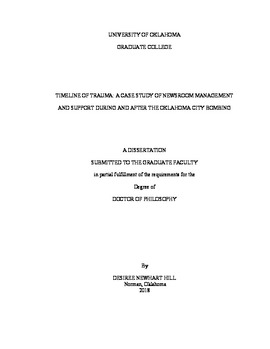| dc.description.abstract | Multiple studies over the past three decades have recognized the emotional consequences of trauma exposure for journalists. The work of journalism requires that reporters, photographers, and other media professionals respond to tragedies and disasters, such as terror attacks, mass shootings, tornadoes, and other emotionally scarring events. For some, the most difficult stories are never-ending, because journalists are required to continue telling the stories of victims, anniversaries, and trials. The range of studies has found that up to 29% of journalists will experience post-traumatic stress disorder (PTSD) during their careers, and that large numbers, up to 98%, have witnessed traumatic events as part of their work. The numbers demonstrate that the work of journalism in many cases is the trauma, but research also indicates that news organizations are often deficient in providing adequate workplace support for employees who may suffer emotionally as a result of their work.
This study uses a grounded theory approach to explore how the 1995 Oklahoma City bombing and other traumatic events that followed changed the way trauma is managed in Oklahoma City newsrooms. The research purpose was to extend the theoretical knowledge of journalism, trauma, and management by analyzing two sets of data. This is the first study to analyze interviews from the Oklahoma City National Memorial's archives, which became Data Set One. Historians at the National Memorial gathered the interviews from 1999 to the present. Sixty interviews were included in the study. The second set of data, Data Set Two, is comprised of interviews with top organizational leaders in Oklahoma City who worked during the time of the bombing.
Analysis of the texts and interviews showed that the local journalists in Data Set One experienced initial and aftermath trauma, including indications of PTSD symptoms, from their work during the bombing. Findings from Data Set One also revealed that multiple support gestures, including perceptions of organizational support (POS) and social support, had a healing effect on journalists. Data Set Two became a conceptual mirror to Data Set One, finding that top organizational leaders recognized some of the journalists' traumatic reactions, although some symptoms of PTSD are not visible. Further, Data Set Two showed that managers themselves also experience emotional trauma in their work. Some became victims of secondary traumatic stress (STS) when journalists they assigned to stories were exposed to primary trauma. Finally, the study found that the shocking event of the bombing lead organizational managers to increase support measures for staff who dealt with the traumatic events that occurred in the years after 1995. These specifically related to counseling, leadership, and social support. Training, however, was one area that did not show significant organizational growth along a timeline from the bombing to the present. Cognitive preparedness and peer-to-peer education are two areas where training can mitigate symptoms of emotional distress post-trauma.
The study extends the understanding of journalism, trauma, and management by connecting journalists' trauma experience to the management response during and after the 1995 Oklahoma City bombing. The study finds that the newsroom leaders in the Oklahoma City market improved trauma response when exposed to multiple large-scale disasters over time, in part, because they, themselves, experience trauma and support alongside the journalists they manage. News organizations which have not experienced shocking, traumatic events with a large loss of life may not experience the same organizational learning about trauma response as those in the Oklahoma City case study, for instance. The findings of this study may be a blueprint for other news organizations, so they can benefit from the organizational learning experienced by the Oklahoma City news organizations' timeline of trauma. | en_US |
